Strings ‘n’ Things
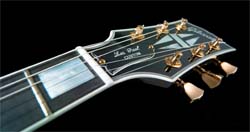 There is a variety of strings that can be chosen for your guitar whether electric or acoustic, contemporary or classical. The choice of string will effect the tone of your guitar.
There is a variety of strings that can be chosen for your guitar whether electric or acoustic, contemporary or classical. The choice of string will effect the tone of your guitar.
Two essential differences are that contemporary guitars use steel strings and classical guitars use nylon strings.
In case you are a beginner and not aware, it can be useful to know that each of the six strings is known by the note to which they are tuned. When in standard tuning these are, from the lowest to highest are, E, A, D, G, B, E. These correspond to the 1st, 2nd, 3rd, 4th, 5th and 6th strings.
Steel strings
The lower four strings, and sometimes the lower three strings depending on choice of gauge, have a steel core around which is wound a coil of wire. The top strings, B and E, and sometimes the G also on a lighter gauged sets of strings, are plain, not wrapped.
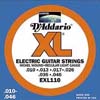 The most popular type of steel guitar string is one that is nickel plated (NPS). They are known for producing brighter tones than if made of nickel purely. They also produce notes longer in sustain than if nickel wound. Example brands of this kind would be ‘Ernie Ball Slinkys’, D’addario XLs and ‘Fender 3250 super bullets.’
The most popular type of steel guitar string is one that is nickel plated (NPS). They are known for producing brighter tones than if made of nickel purely. They also produce notes longer in sustain than if nickel wound. Example brands of this kind would be ‘Ernie Ball Slinkys’, D’addario XLs and ‘Fender 3250 super bullets.’
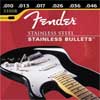 Stainless Steel strings – These are the hardest of the strings and therefore may cause the most wear to frets over time. They produce the brightest of tones and keep their tonal character longer compared with strings that are nickel wound or nickel plated which react more to oil and sweat from the player’s hands and to the the elements. These cause strings to oxidise and their tone to become noticeably blunt. An example of stainless steel strings would be the Fender 3350 Stainless Bullets.
Stainless Steel strings – These are the hardest of the strings and therefore may cause the most wear to frets over time. They produce the brightest of tones and keep their tonal character longer compared with strings that are nickel wound or nickel plated which react more to oil and sweat from the player’s hands and to the the elements. These cause strings to oxidise and their tone to become noticeably blunt. An example of stainless steel strings would be the Fender 3350 Stainless Bullets.
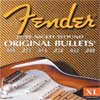 Nickel wound strings: These were the type of strings originally produced for the earlier electric guitars during the 1950s. They are therefore chosen when seeking more of a vintage tone. They produce a warmer sound than stainless steel and nickel plated strings and can feel a little softer under the finger tips in comparison also. An example would be Fender 3150 Bullet End strings.
Nickel wound strings: These were the type of strings originally produced for the earlier electric guitars during the 1950s. They are therefore chosen when seeking more of a vintage tone. They produce a warmer sound than stainless steel and nickel plated strings and can feel a little softer under the finger tips in comparison also. An example would be Fender 3150 Bullet End strings.
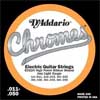 Each of the string varieties above have a round wrapping of wire about the inner steel core. There is another type of string, less popular but available. These are flat wound strings. Their round coil is squared off a little, making them feel flatter and comfortable under the fingers. There is less chance of dirt and oil building up in any grooves so they tend to last longer. Because of their shallow profile, they are also less abrasive to the frets. So it seems there are many positives about flat wound strings except that they are more costly to make, and, most importantly, they are noticeably flatter and softer in tone than the alternatives, so not a popular option. An example set would be D’Addario ECG24 Chromes.
Each of the string varieties above have a round wrapping of wire about the inner steel core. There is another type of string, less popular but available. These are flat wound strings. Their round coil is squared off a little, making them feel flatter and comfortable under the fingers. There is less chance of dirt and oil building up in any grooves so they tend to last longer. Because of their shallow profile, they are also less abrasive to the frets. So it seems there are many positives about flat wound strings except that they are more costly to make, and, most importantly, they are noticeably flatter and softer in tone than the alternatives, so not a popular option. An example set would be D’Addario ECG24 Chromes.
The plain, unwound, strings on electric and acoustic guitars are the same.
Ball End and Bullet Ended Strings
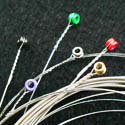 Most strings have a hollow ball shaped end around which the string is wound to finish it and to make connection with the bridge of the guitar. Fender make some of their strings to have a bullet shaped ending to which the string is soldered and this was intended to help the string seat itself well in the tremolo block of their Stratocaster guitar.
Most strings have a hollow ball shaped end around which the string is wound to finish it and to make connection with the bridge of the guitar. Fender make some of their strings to have a bullet shaped ending to which the string is soldered and this was intended to help the string seat itself well in the tremolo block of their Stratocaster guitar.
String Gauge:
As well as being made from different materials, strings are available in a variety of gauges, width of diameter. Those of a small gauge are normally found easier to play, however the gauge will have an effect on the tone of the guitar. String diameters are measured in thousandths of an inch. The lighter gauges of strings will feel eaiser to play, but the heavy gauges of strings will give more sustain and will sound louder.
Strings sets are available with a range of different gauges, and quoted from the lightest 1st strings to the heaviest sixth string. An example of a very light first string would be a 9 gauge string, this would have a diameter 0.009 inches. Sets of strings typically have different names by their manufactures. By choosing a set of strings you will be able to adjust the treble of the high strings and deepness and warmth in the bass of the lower strings to suit your taste as well as to find the set of strings you feel most comfortable with when playing. Often the guitar set we use is denoted by the gauge of the first string. So for example, and guitarist may be said to use a set of 10s or 11s. Electric guitar gauges usually start between 8 to 12 gauge, most popular being 9 and 10 gauge, and acoustic guitars 10 – 13 with a 12 gauge considered ‘light’ on an acoustic guitar, while considered ‘heavy’ for an electric guitar.
The scale length of the guitar will also have a bearing upon how the strings feel to play. A Gibson type of guitar, for example, is of shorter scale length than a Fender styled guitar. This means that the strings will be at differnt tensions when tuned on either of the guitars. Heavy gauge strings will feel slacker on the shorter scale guitar than if fitted to a Fender style guitar and visa versa.
